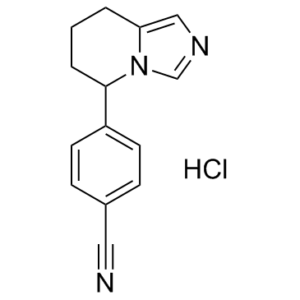Fadrozole HCl (CGS-16949A)
This product is for research use only, not for human use. We do not sell to patients.

For small sizes, please check our retail website as below: www.invivochem.com
| Size | Price | Stock |
|---|---|---|
| 100mg | $450 | Check With Us |
| 250mg | $800 | Check With Us |
| 500mg | $1200 | Check With Us |
Cat #: V20900 CAS #: 102676-31-3 Purity ≥ 98%
Description: Fadrozole (CGS 16949A) is a highly potent and selective nonsteroidal aromatase inhibitor (IC50 of 6.4 nM) with potential antineoplastic activity.
Top Publications Citing Invivochem Products
Publications Citing InvivoChem Products
Product Promise

- Physicochemical and Storage Information
- Protocol
- Related Biological Data
- Stock Solution Preparation
- Quality Control Documentation
| Molecular Weight (MW) | 259.73 |
|---|---|
| Molecular Formula | C14H14ClN3 |
| CAS No. | 102676-31-3 |
| SMILES Code | N#CC1=CC=C(C2CCCC3=CN=CN23)C=C1.[H]Cl |
| Synonyms | Fadrozole; CGS 16949A; CGS-16949A; CGS16949A;Fadrozole HCl; Fadrozole hydrochloride; |
| Protocol | In Vitro | Fadrozole hydrochloride is a potent, selective and nonsteroidal inhibitor of aromatase with an IC50 of 6.4 nM. In hamster ovarian slices, Fadrozole hydrochloride inhibits the production of estrogen with an IC50 of 0.03 μM. The production of progesterone is inhibited with an IC50 of 120 μM. Synthesis of other cytochrome P-450 dependent steroids can be suppressed to various degrees with higher doses of Fadrozole hydrochloride. |
|---|---|---|
| In Vivo | Fadrozole hydrochloride is able to inhibit the aromatase-mediated uterine hypertrophy in immature female rats with an ED50 of 0.03 mg/kg when given orally. In the same model, aminoglutethimide elicits the same effect with an ED50 of 30 mg/kg when given orally. |
These protocols are for reference only. InvivoChem does not
independently validate these methods.
| Solvent volume to be added | Mass (the weight of a compound) | |||
|---|---|---|---|---|
| Mother liquor concentration | 1mg | 5mg | 10mg | 20mg |
| 1mM | 3.8502 mL | 19.2508 mL | 38.5015 mL | 77.0030 mL |
| 5mM | 0.7700 mL | 3.8502 mL | 7.7003 mL | 15.4006 mL |
| 10mM | 0.3850 mL | 1.9251 mL | 3.8502 mL | 7.7003 mL |
| 20mM | 0.1925 mL | 0.9625 mL | 1.9251 mL | 3.8502 mL |
The molarity calculator equation
Mass(g) = Concentration(mol/L) × Volume(L) × Molecular Weight(g/mol)
Mass
=
Concentration
×
Volume
×
Molecular Weight*
The dilution calculator equation
Concentration(start)
×
Volume(start)
=
Concentration(final)
×
Volume(final)
This equation is commonly abbreviated as: C1 V1 = C2 V2
Concentration(start)
C1
×
Volume(start)
V1
=
Concentration(final)
C2
×
Volume(final)
V2
Step One: Enter information below
Dosage mg/kg
Average weight of animals g
Dosing volume per animal µL
Number of animals
Step Two: Enter the in vivo formulation
%DMSO
+
%
+
%Tween 80
+
%ddH2O
Calculation Results:
Working concentration:
mg/ml;
Method for preparing DMSO master liquid:
mg
drug pre-dissolved in
µL
DMSO(Master liquid concentration
mg/mL)
,Please contact us first if the concentration exceeds the DMSO solubility of the batch of drug.
Method for preparing in vivo formulation:
Take
µL
DMSO master liquid, next add
µL
PEG300, mix and clarify, next add
µL
Tween 80,mix and clarify, next add
µL
ddH2O,mix and clarify.
Note:
- (1) Please be sure that the solution is clear before the addition of next solvent. Dissolution methods like vortex, ultrasound or warming and heat may be used to aid dissolving.
- (2) Be sure to add the solvent(s) in order.




































